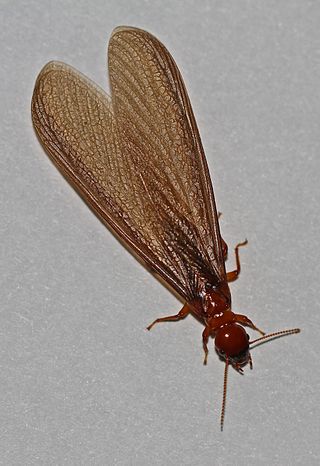Michael S. Engel, FLS, FRES is an American paleontologist and entomologist, notable for contributions to insect evolutionary biology and classification. In connection with his studies he has undertaken field expeditions in Central Asia, Asia Minor, the Levant, Arabia, eastern Africa, the high Arctic, and South and North America, and has published more than 925 papers in scientific journals and over 1000 new living and fossil species. Some of Engel's research images were included in exhibitions on the aesthetic value of scientific imagery.

Mastotermitidae is a family of termites with one sole living species, Mastotermes darwiniensis which is found only in northern Australia. The remaining genera of this family are only known from the fossil record.
Termopsidae is an extinct family of termites in the order Blattodea. The five extant genera formerly included in Termopsidae are now treated as part of the newer family Archotermopsidae, leaving only extinct taxa in Termopsidae.

Parastylotermes is an extinct genus of termite in the Isoptera family Stylotermitidae known from North America, Europe, and India. The genus contains five described species, Parastylotermes calico, Parastylotermes frazieri, Parastylotermes krishnai, Parastylotermes robustus, and Parastylotermes washingtonensis.
Serritermitidae is a family of termites belonging to the infraorder Isoptera in the order Blattodea. The family includes only a few species, which live in South America.
Ceylonitermes escherichi is a species of termite. It is endemic to Sri Lanka.

Blattoidea is a superfamily of cockroaches and termites in the order Blattodea. There are about 17 families and more than 4,100 described species in Blattoidea.

Archotermopsidae is a family of termites in the order Blattodea, known as dampwood termites, formerly included within the family Termopsidae. They constitute a small and rather primitive family with two extant genera and 5 living species. They may rarely infest structures but do not usually do so, nor do they cause extensive damage to buildings or other man-made structures unless said structure has been sufficiently damaged such as by water. As their name implies, they eat wood that is not dried out, perhaps even rotting, and consequently of little use to humans.

Gnathamitermes perplexus, the long-jawed desert termites or tube-building termites, is a species of termite in the family Termitidae. It is found in Central America and North America. The species creates tunnels, with both colony founders and workers transporting sand to excavate tunnels using their mandibles. The species is particularly susceptible to infectious nematodes such as Steinernema riobrave.
Reticulitermes hageni, the light southeastern subterranean termite, is a species of termite in the family Rhinotermitidae. It is found in North America.
Neotermes castaneus, known generally as the southern damp-wood termite or Florida dampwood termite, is a species of termite in the family Kalotermitidae. It is found in the Caribbean Sea, Central America, North America, and South America.
Marginitermes is a genus of termites in the family Kalotermitidae. There are at least three described species in Marginitermes.
Tenuirostritermes is a genus of termites in the family Termitidae. There are about five described species in Tenuirostritermes.
Kumar Krishna was an American entomologist of Indian origin. He was an expert on the termites and published the definitive systematic treatment of the termites of the world in a seven volume Treatise on the Isoptera of the world in 2013 written with collaborators.

Stolotermitidae is a family of termites in the order Blattodea, with two extant genera formerly placed in the family Termopsidae. There are about 14 described species in Stolotermitidae.

Hospitalitermes is an Asian–Papuan genus of lichen-eating termite in the subfamily Nasutitermitinae. There are 37 species currently listed, of which most are recognized for their extensive surface foraging columns. Due to their conspicuous foraging activities, they are commonly known as processionary or marching termites. They often inhabit cavities inside of living trees excavated by other species of termite.
Archeorhinotermes is an extinct genus of termites in the family Archeorhinotermitidae, and is the sole genus of the family. There is one described species in Archeorhinotermes, A. rossi. It was discovered in Burmese amber.
Cratomastotermes is an extinct genus of termites in the family Cratomastotermitidae, the sole genus of the family. There is one described species in Cratomastotermes, C. wolfschwenningeri.
The Syntermitinae, also known as the mandibulate nasutes, is a Neotropical subfamily of higher termites represented by 21 genera and 103 species. The soldier caste of members of this subfamily have a conspicuous horn-like projection on the head which is adapted for chemical defense, similar to the fontanellar gun of true nasute termites. However unlike true nasutes, the mandibles of the soldiers are functional and highly developed, and they are unable to expel their chemical weaponry at a distance – instead relying on direct physical contact. Some genera, such as Syntermes or Labiotermes, have a highly reduced nasus and in some species it may appear absent altogether. Although the Syntermitinae were once grouped and considered basal within the Nasutitermitinae, they are not closely related with modern cladistic analyses showing Syntermitinae to be a separate and distinct lineage that is more closely related to either the Amitermes-group or MicrocerotermesTermitinae. It is believed the nasus evolved independently in Syntermitinae in an example of convergent evolution. Genera range from southern Mexico (Cahuallitermes) to Northern Argentina with the highest diversity occurring in the Brazilian Cerrado.

The Cubitermitinae are an Afrotropical subfamily of higher termites with 28 known genera and 147 species. The nests of most taxa are either subterranean or found within the mounds of other termite species. The most well known genus of this subfamily is Cubitermes, which commonly build epigeal nests with one or more caps used to shield the nest against rainfall, giving them a characteristic mushroom shape. Most members of this subfamily are soil-feeders.








